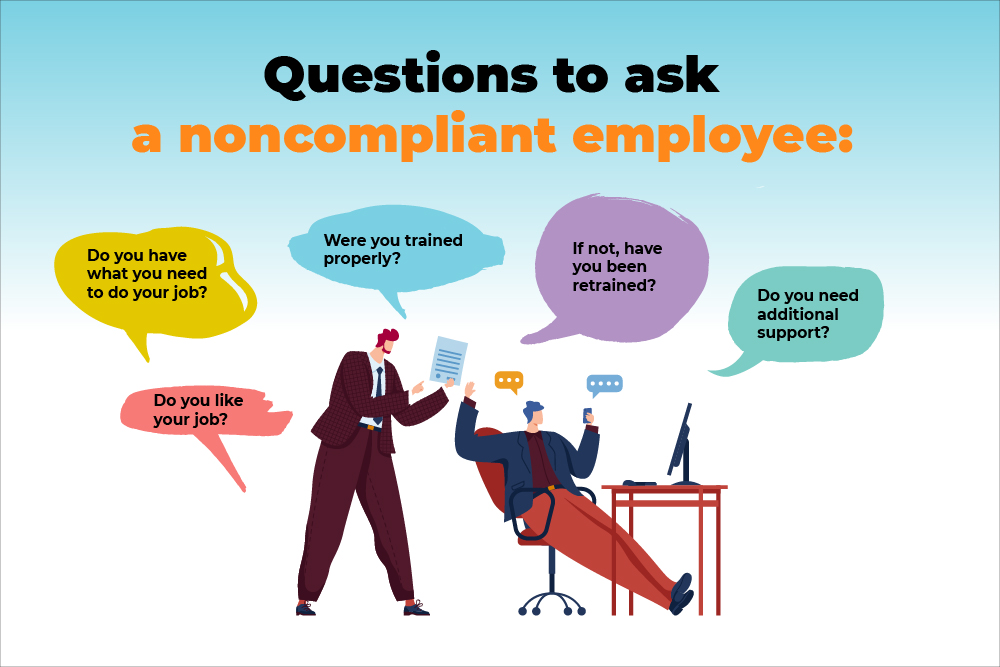Corporate leaders and managers have plenty to focus on, but negative workplace behavioral issues may be the most critical issue to address. Successfully navigating this challenge means giving leaders the support, training, and guidance they need.

What issues are we seeing?
According to the Society for Human Resource Management, negative workplace behavioral issues can cause issues for employees and companies, like gossiping, displaying incivility and insolence, bullying, and insubordination.
Disruptive behavior can negatively affect and disengage employees. When other employees are near these types of behavior, they can mirror it. For example, they might avoid work and call in sick more regularly. If they think management will allow this behavior to continue, they’ll continue to disengage, their productivity will slow down, and they may even leave the company.
It’s critical for leaders to prevent this issue, but this is easier said than done. There are challenges in addressing workplace behavior. For one thing, doing so is uncomfortable. It’s not like when someone violates a direct rule because then all they have to do is point to a handbook or policy to back up the corrective action.
Addressing a bad attitude, a micro-aggression, or someone rolling their eyes at a co-worker isn’t as direct of an issue. Also, incidents like these are often overlooked or brushed off as an employee having a bad day. Managers might tell themselves, “Oh, that wasn’t that bad.” It is that bad because allowing negative behaviors to continue will create a toxic culture.
So how can you determine the effects of negative workplace behavior on your business and whether it’s a significant problem?
A good first step is to use whatever metrics are available to your business and analyze any trends. Say you hire a new employee for a specific team, and that team has an unexpected increase in turnover. They may also see a decrease in their job satisfaction survey scores. At that point, dig deeper and see whether you can trace the cause back to the new hire’s behavior.
Keep a lookout for changes in other metrics, like:
- Number of exit interviews
- Customer or guest service scores
- Turnover for a specific team or department
- Productivity measurements
Addressing employee’s behavioral issues
Picture this. A manager comes into the office and tells you they’d like to get rid of someone. This employee has a bad attitude; they’re lazy and sigh whenever they’re given a task. They never get any work done.
What’s the story here?
Workplace behavior should be examined for the root cause. According to author and Forbes Business Council member Jason Van Camp, managers need to “figure out what’s causing the behavior. Determine if it’s something that can be worked on. Most behavior results from communication issues or a lack of understanding on someone’s part.
“If it’s fixable, work on how mutually to fix it or do so as a team. If it’s not fixable, act quickly to limit, manage and, if ultimately necessary, remove the bad actor before the situation degrades further.”
It might be best to hold a one-to-one conversation with the employee and see if you can identify:
- What might be driving their behavior
- Why they aren’t doing a certain task
- Why aren’t they doing their job the way they should be
Connecting and communicating with the employee may also help you understand outside factors affecting them. While leaders usually aren’t trained counselors, they can still listen, be empathetic, and guide employees to resources or help, like an Employee Assistance Program, a leave of absence, or some other form of professional assistance.
Human resources professional Denise Domain recommended, “Never take anything at face value. You may think that the associate is being difficult, but in reality, there is a legitimate reason for [their] frustration. If you can work through the issue, you may be able to turn the situation around.”
Here are a few questions you could ask an employee to help you figure out why they’re acting out:
- Do you have the supplies and tools to effectively complete the job?
- Have you been trained in the steps of correctly doing this job?
- Do you have the skills to execute the tasks you’ve been trained on?
- Has anyone told you that you’re not following the correct steps and shown you how to do it correctly?
- Tell me about your typical shift; what’s working well? Where do you need more support?
- Do you enjoy the work you’re performing?
- Is this job what you expected it to be?
Sometimes, employees aren’t set up for success. They need training or tools; if they don’t have them, they can lash out in frustration. If new hires aren’t enjoying what they’re doing within their first three months or are frustrated over roadblocks or a lack of supplies, they’ll leave and try again elsewhere.
A new hire isn’t committed yet. They don’t have insurance and aren’t out of their probation period. In other words, the deal isn’t sealed. They conclude that if this is their welcome, things aren’t likely to be any better within a year. It’ll just be easier for them to try another company.
Other times, negative workplace behavioral issues can be attributed to an employee’s unmet needs. That can result in workplace behavioral issues cropping up, like conflict, slow work, and blatant misconduct.
A few universal employee needs include:
- To be heard
- To be valued
- Trust
- Safety
- Acceptance and belonging
- Respect
- Fair and accurate pay
Meeting employees’ needs should be the leadership’s responsibility. Address unmet needs in department meetings, focus group sessions, and training. You can do likewise through confidential employee surveys or one-to-one chats. This will also allow you to create positive workplace behavior strategies.
Robert Brill of Brill Media noted, “While we can’t correct all bad behavior, we do provide opportunities for our people to correct those patterns with training, one-to-one dialogue and guidance on how to improve.”
How do we address negative workplace behavior?
Knowing an employee’s negative behavior needs to be addressed is one thing; correcting it is another. Again, no one enjoys conflict. It can be hard to tell an employee that their behavior is unacceptable, their comment was out of bounds, or they’re making life difficult for others. This can be even harder when the employee responds aggressively or their supervisor doesn’t know how to address the behavior.
But the issue can’t be ignored. Otherwise, it’ll lead to a workplace crisis that could be even more difficult to deal with.
To correct poor behavior, teach leaders effective steps for providing feedback, like how to coach in the moment. They need guidelines on communicating professionally and consistently and the chance to role-play or practice.
Imagine that another HR manager wants an employee to change their behavior. They call the employee into the office, slide a performance improvement plan across the desk, and tell them to read and sign it.
Imagine the impact on the employee. Did they get asked questions about the situation or their side of the story? How will they feel walking away from this interaction? Will they be motivated to change? Probably not. If anything, they could come away from the meeting feeling resentful, escalating their problematic behavior.
It’s better to increase the frequency of corrective action conversations, reducing the number of offenses requiring written warnings. Per Kandis Porter, founder of Effective Flow Connections, “Leaders must correct bad behavior swiftly and in private.”
Swiftly is the key here. If a leader waits even a few weeks, think of how many times the behavior will be repeated. When it’s finally mentioned, the employee will wonder why nobody told them by now that their behavior was wrong. This can make them feel unnecessarily embarrassed, ashamed, or angry.
There’s also the danger that when leadership allows poor behavior, an “almost-rude” comment, or a micro-aggression against a co-worker, others will notice and think this behavior is acceptable.
That will set up a negative culture that tolerates bad behavior. Delayed responses can exacerbate bullying, alienate employees, and diminish strong performers. What will keep people from repeating or copying this behavior if there are no consequences?
Take particular note of microaggressions—smaller slights that may be unintentional but are still upsetting. According to the Harvard Business Review, “The reality is that microaggressions are not so micro in terms of their impact. They should be taken seriously, because at their core they signal disrespect and reflect inequality.”
Microaggressions may not appear to violate clear rules. Leaders may think it’s a small comment or not worth the time it will take to discuss the situation. It’s critical that they do. A microaggression is like a paper cut: you get one that hurts but is not a grievous injury.
But imagine getting a paper cut every day in the same spot repeatedly. It won’t take long before you have a deep wound. There’s a real impact on others if negative workplace behavior is allowed to continue.
Issues at work, particularly behavioral ones, are difficult to handle. Creating a workplace engagement health strategy that can be executed over time and includes all levels of leadership will help move the needle toward a more positive and engaged workplace.
Begin with a self-audit of your company’s employee relations health and develop a positive workplace behavior strategy. Analyze metrics looking for trends and conduct employee focus groups to get the pulse of the team. Ensure your handbook and policies all focus on positive workplace behavior.
Train your leadership team on transparent communication and immediately addressing negative workplace behavior. Emphasize swift coaching, along with consistent, firm, and fair leadership.
Subscribe to Our Newsletter
Join 80,000+ Fellow HR Professionals. Get expert recruiting and training tips straight
to your inbox, and become a better HR manager.

 Dari DeSousa
Dari DeSousa 

